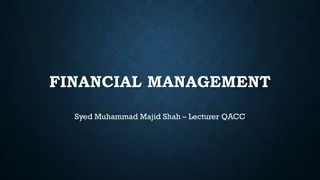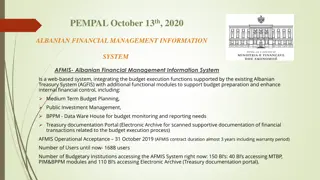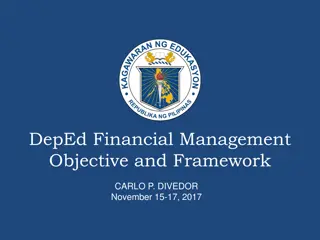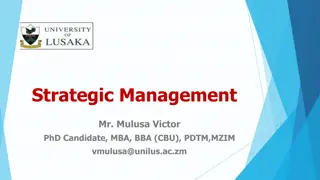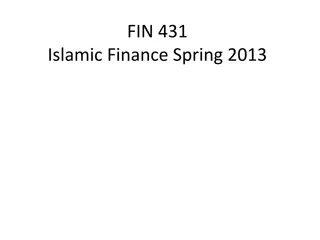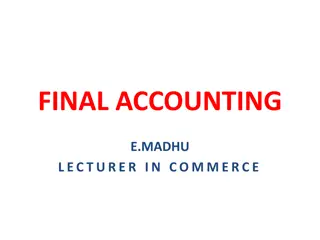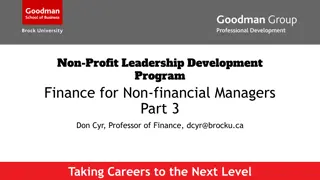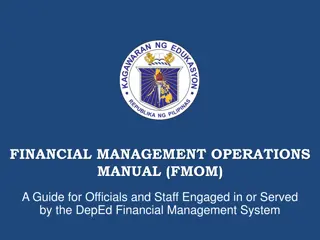Financial Management Essentials: Understanding the Fundamentals
Financial management involves planning, acquiring, and utilizing funds to maximize efficiency and value within a firm. It encompasses forecasting, investment decisions, risk management, and more. From financing to working capital management, this field addresses crucial questions on capital investment, raising funds, and day-to-day financial activities. Explore the core principles and practices to excel in financial management.
Download Presentation

Please find below an Image/Link to download the presentation.
The content on the website is provided AS IS for your information and personal use only. It may not be sold, licensed, or shared on other websites without obtaining consent from the author. Download presentation by click this link. If you encounter any issues during the download, it is possible that the publisher has removed the file from their server.
E N D
Presentation Transcript
COURSE CONTENT chapter 1: Introduction 1. General Introduction 2. Goals of financial management 3. Functions of financial management chapter 2:Financing decision 1. Short term financing 2. Intermediate term financing 3. Long term financing
chapter 3: Firms financial operation 1. Financial statements 2. Financial analysis Chapter 4: Investment policy 1. The time value of money 2. Investment appraisal 3. Capital budgeting on contract investment 4. A system of control levels
Chapter 5:Working capital management 1. Working capital policy 2. Cash & liquid management 3. Credit management 4. Inventory management
chapter 1: Introduction What is financial management all about? FM is the planning for, acquiring (gain for one self) and utilizing of funds in order to maximize the efficiency and value of the firm It involves -Forecasting and planning -Major investment and financing decisions -Coordinate and control -Risk management
Financial management is the managerial activity which is concerned with the planning and controlling of the firm s financial resources. It was a branch of economics till 1890, as a separate discipline, it is of recent origin. ( financial management, 9thedition ,I M Pandey p.3) Financial management = planning + controlling financial resources.
No matter what the nature of the proposed business is and how it is organized, one has to address the following questions in financial management. What capital investment should be made? That is what kind of material and equipment should be purchased, or building to be rented etc. How and where the money to pay for the proposed capital investment should be raised? How the day-to-day financial activities are handled like collecting the receivables and paying the suppliers? 1. 2. 3.
Today it has broaden to deal with issues like Which new proposal for employing capital should be accepted by the firm? What steps can be taken to increase the value of the firms common stocks? How much working capital will be needed to support & expand the companies operation? Where should the firm go to raise the short and long-term capital demand and how much will it cost? Should a firm declare a cash dividend (share b/n share holder) on its common stock and if so how much a dividend should be declared?
The term finance can be defined as the management of the flows of money or its equivalent through an organization, weather it is a for or not-for profit firms, corporation or non-corporation business, or government agency. Finance concerns its self with the actual flow of money as well as any claim against money. The flow of funds is a continuous process.
Owners Managers Lenders Suppliers Customers Investment analysts Competitors Employee Government Community representatives
There are basically three arrangements Sole proprietorship Partnership Limited company
An individual is the sole (one and only) owner Often small business The number of such business is very large Easy to set up(organize) The law doesn t recognize it separate from the owner when the owner dies the business ceases (stop) Single tax
At list two individuals (owner) Much in common with Sole proprietorship
Minimum two individuals Liability (legally bound) is limited In many cases owners are not involved in day-to-day activities It has regulations even to start part of which to prepare annual financial report Double taxation
In the larger limited companies A board of directors is appointed by owners ( shareholders) to oversee the running of the business.
What is the reason to start and run a company( business)?
Profit maximization Is vague (profit in the short run might be different from profit in the long run) no consideration for P PC balance It leaves consideration of timing and duration undefined (there is no guide for comparing profit now with profit in future or for comparing profits streams of different durations)
It overlook future aspects Some business have placed a high value on the growth of sales and are willing to accept lower profits to gain stability of the market sales, Other business recognize diversifying their activities into different products that strengthen the firm but short term decline in profit. Others firm use a portion of their profits to achieve social goals or to make contributions to society.
Wealth maximization Avoid high level of risk Pay consistent; dividend (share of profit paid to share holder) by paying consistent (equal) dividends, the firm helps attract investors seeking cash income, which maintain the market value of the stocks and keep up its present value. Seek growth in sales; as a firm increases its sales and develops new markets for products, it protects itself against economic recessions (decline) changes in consumer preferences or other reductions in demand for the firm s products. However profit may decrease from the additional cost required for promotion and secure attraction of various customers. Maintain market price of stocks
1.Liquidity functions: this means that the firm has adequate cash on hand to meet its obligation at all times.( or the firm can pay all its bills when due and have sufficient cash to take unanticipated discounts for large cash purchases) Forecasting cash flow Raising funds Managing the flow of internal funds
2. Profitability functions: In seeking profit for the firm the financial manager shall provide specific input into the decision- making process based on financial training and actions. Forecasting profit Cost control Pricing Measuring risk-return of a proposal
3. Managing assets: assets are the resources by which the firm is able to conduct business. The term assets includes buildings, machinery, vehicles, inventory, money and other resources owned by the firm. A firm s asset must be carefully managed and a number of decisions must be made concerning their use. The decision making role crosses liquidity and profitability lines. Converting idle equipment to cash improves liquidity, reducing costs improves profitability.










